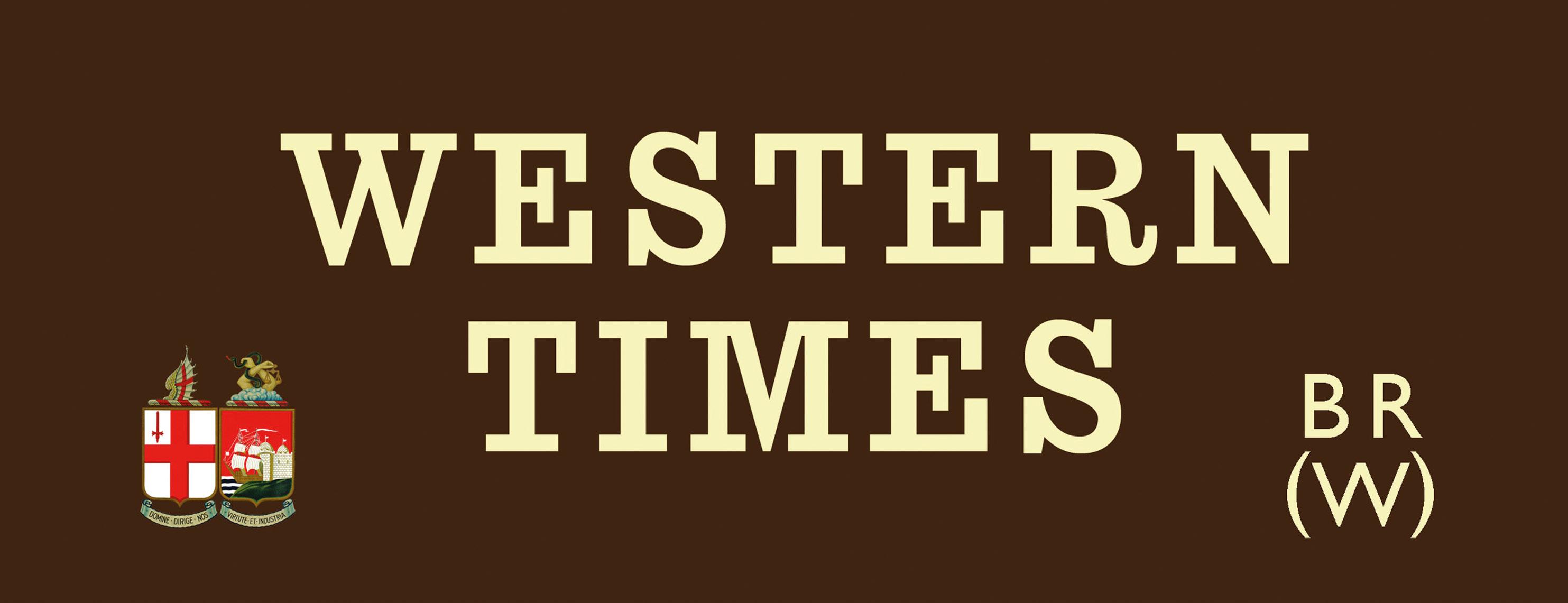
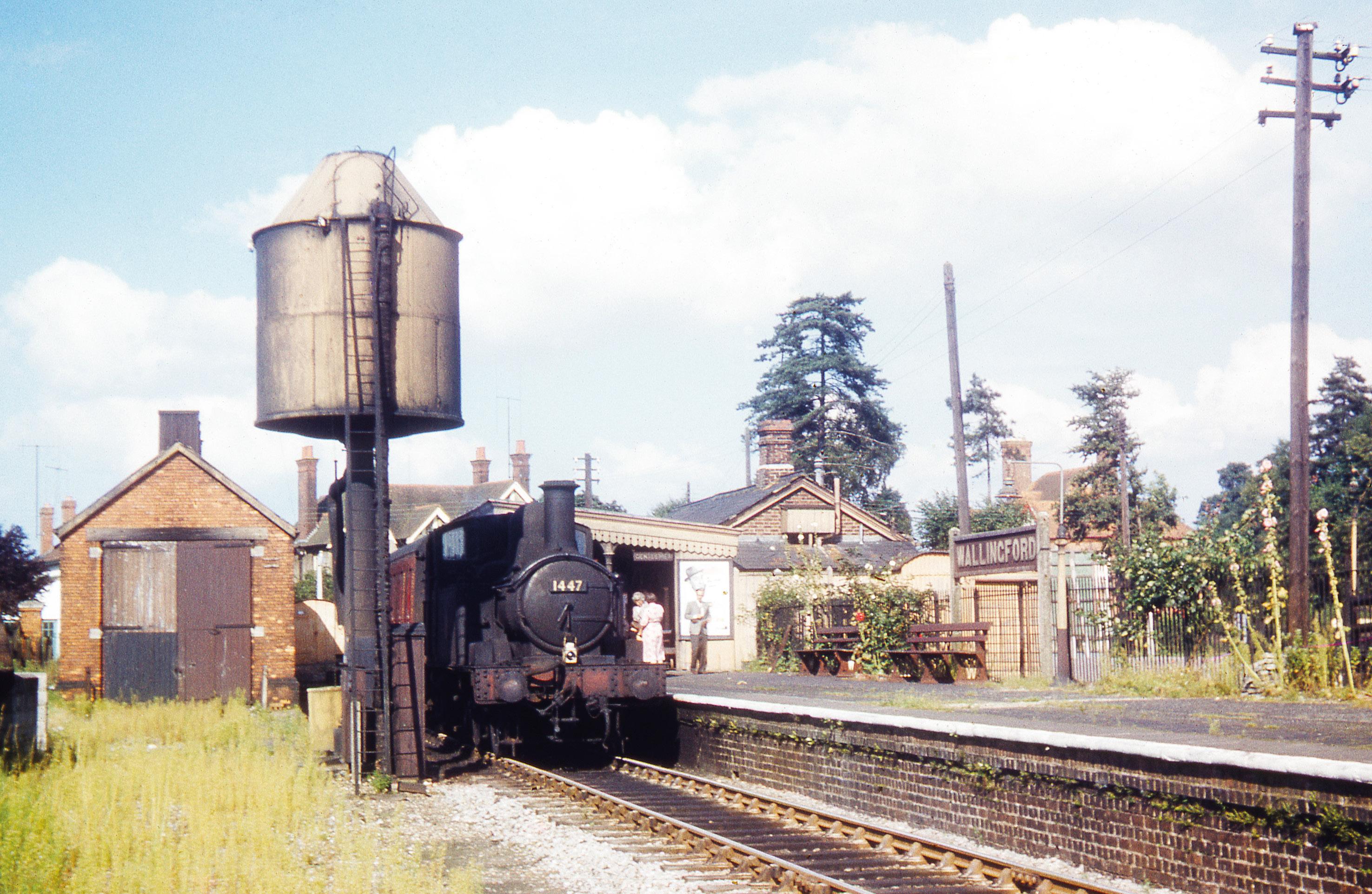
The history periodical for students of the GWR and BR(W)
ISSUE No.9 - SPRING 2024
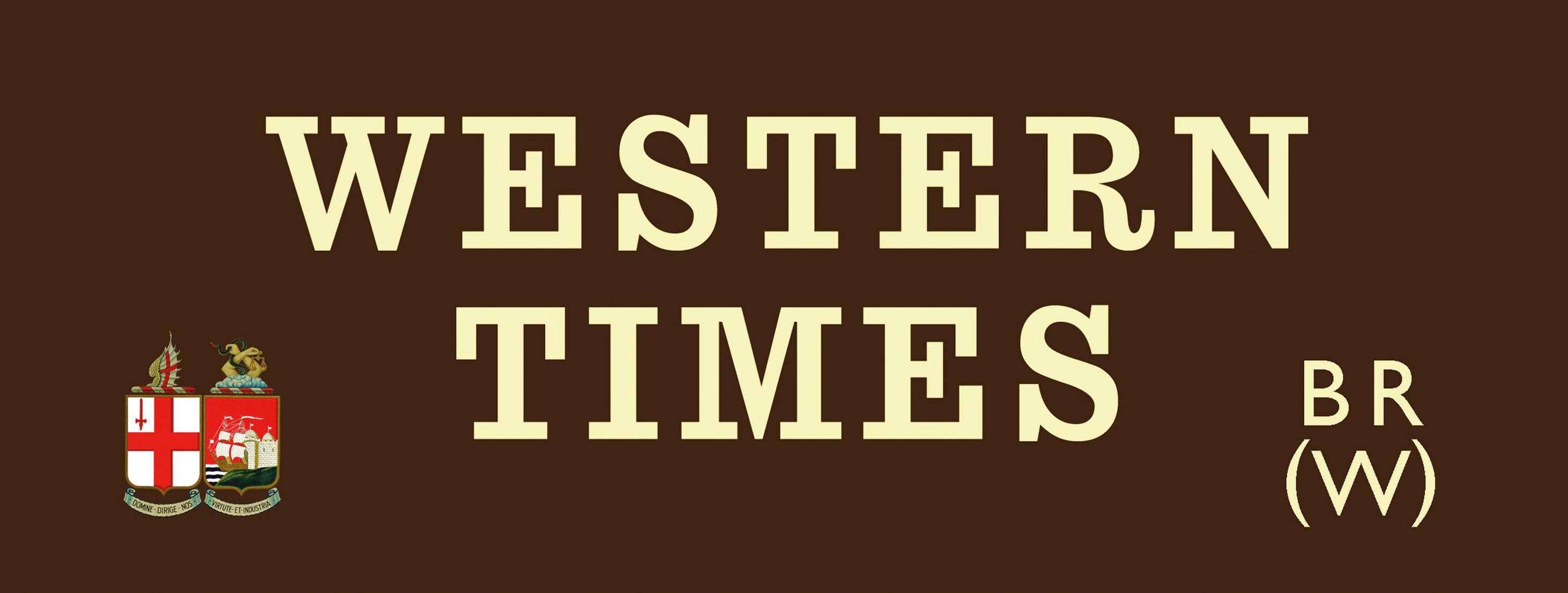

3 4 21 34 39 40 48 50 58 66 71 73 78 79 Introduction Stroud’s Golden Valley by Alan Postlethwaite The Pannier Story: Part 1 - Beginnings From the Archives of R C Riley: Sunday 26 February 1939 Book Review Forty Pairs of Numberplates: Part 2 - Tender Engines Upton in 1900 by Sean Bolan GRA Modern Traction: Nocturnal Westerns in Colour Footplate Recollections of a Lucky Man by Brian Wheeler Oxford in World War 2 From the Archives: 4-4-2T No. 4600 Branch Line to Wallingford The Great Western Trust (GWT) - Bulletin No.8 The Guard’s Compartment Contents ISSUE No.9 - SPRING 2024
MrT R Perkins, a man whose name is possibly less familiar among younger generations, made his mark before World War 2 by travelling the entire railway system of the United Kingdom then open to public services. This achievement can never be equalled as the total route mileage then was vastly greater than today’s Beeching-truncated network. TRP’s triumph was all the more remarkable in that it was achieved mainly during his annual holidays. Most of his spare time for the rest of the year must have been devoted to poring over timetables to minimise delays between connections to keep on the move. His feat, which took about 12 years and was completed in 1929, stands at the apogee of the determination and resilience displayed by so many who love railways.
The editorial team’s activities extend beyond propagation of Western Times, and a recent assignment involved the proof-read of a new work based on experiences that have a flavour of the TRP saga. It concerns a railway geographically far removed from the GWR and within the time frame of the 1980s and 1990s i.e. outside the self-imposed 1977 boundary that governs WT. The work subjected to the proofing process stands out as the text was drawn from detailed notes, and the photographs were extracted from a collection of over 30,000 images. All this base material was the subject of the author’s own labour i.e. the work of one man. Although never a professional railwayman, for several years he held a fully authorised ‘all lines’ footplate pass which allowed him aboard locomotives that penetrated freight-only routes and rarely used industrial sidings in addition to the lines used by public services. In that respect, this odyssey traversed a wider spectrum of the system’s operations than TRP could have managed many years earlier.
Countless hours spent riding locomotives and in lengthy delays awaiting connections made it inevitable that many friendships should have developed with working railwaymen. Thus extended dialogues ‘inside the fence’ with expert practitioners rendered authoritative explanation and confirmation of conclusions drawn by this ‘amateur’ observer. The resultant commentary is thus imbued with enviable authenticity because the information was assembled in real time
This attribute contrasts with the processes adopted in the composition of Western Times. The GWR with its associated enterprises is probably the most comprehensively catalogued of Britain’s major railways, yet much information is effectively second-
hand. Review of topics increasingly remote through the passage of years makes accurate capture of the organisation’s texture challenging. Deduction or argued speculation risks assumption of the status of proven fact, perhaps erroneously endorsed by repetition in other publications. Admission of ignorance is a useful weapon in enticing those with superior knowledge to correct or to contribute to the back story. Research is immensely enjoyable but has a voracious appetite for time so any measure that helps share the load is welcome. This is why the ‘Guard’s Compartment’ column is so important.
Recognition of contemporary factors is relevant. WT Issue 6 included a commentary on the short working lives of Hawksworth coach stock, particularly the suburban vehicles. The following issue included useful information from a reader which inter alia contended that inferior damage resistance justified early replacement in favour of BR Mark 1 vehicles. It would be interesting to know whether differing resilience levels warranted premature withdrawal of far from fully amortised capital assets. In the modern world, much emphasis is placed on safety but how relevant a factor was this in the equation at the close of the 1950s? Also, Beeching’s conclusions on poor stock utilisation are directly linked with his 1962 report whereas, for example, the scrapping of Diagram E166 Suburban Composite coaches was well under way by December of that year, before the good Doctor’s conclusions could have been implemented.
The reader’s comments about compartment accommodation on suburban services were apposite, evoking memories of the daily crawl around the Catford loop in a grimy, dusty Southern 4-SUB during the warm summer of 1966. The success of the pre-war GWR diesel railcar fleet was in part due to the saloon-type accommodation and it was unfortunate that this popular feature failed to translate to post-war steam-hauled suburban services. Was this a case of stocking and operating services in accordance with the dictates of tradition without thought for what the paying passenger might prefer?
Editor: Andrew Malthouse Editorial Assistant: Jeremy Clements
To contact the editorial team please email: WesternTimes@mail.com
For sales, subscriptions and back issues of Western Times please go to: www.ttpublishing.co.uk
--- o O o---
3 ISSUE 9
INTRODUCTION
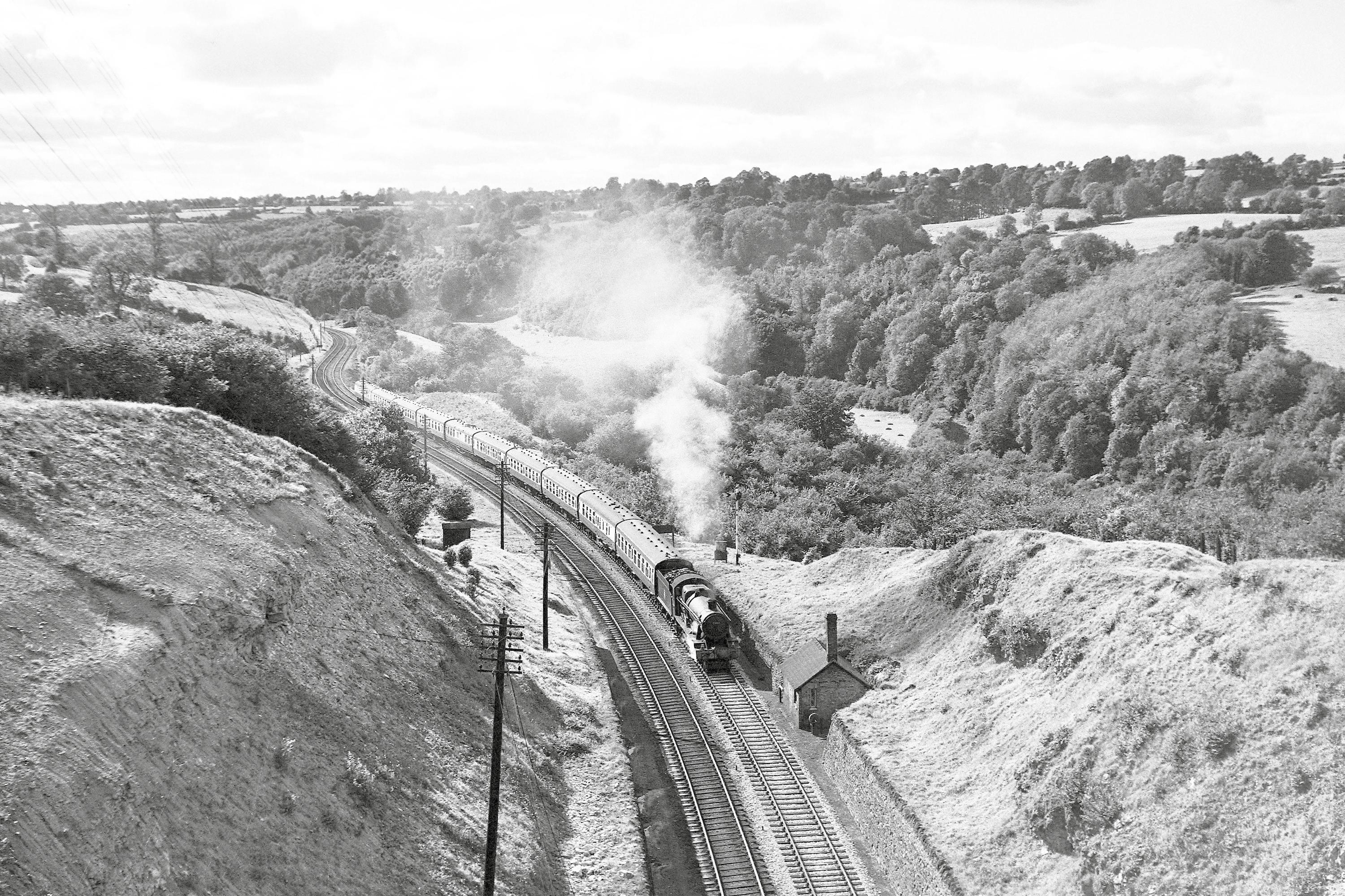

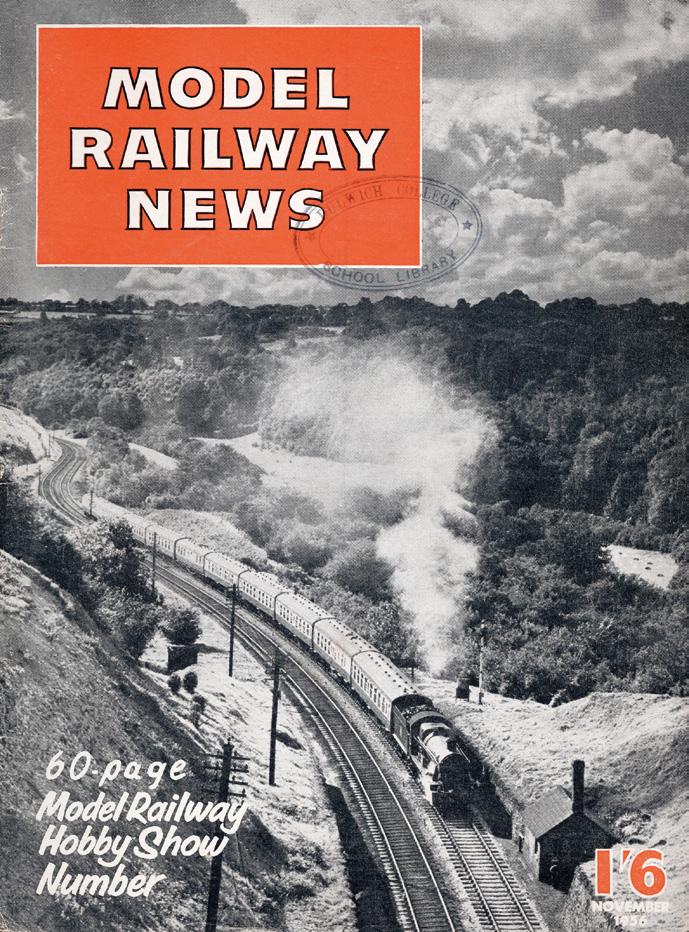
Model Railway News ran from 1925 to 1971 and was published by Percival Marshall. George Heiron’s ‘Sapperton Bank’ photograph appeared on the November 1956 issue cover (above). It was an inspiration for the author to take up railway photography. However, a design slip-up was made in making the far hillside horizontal, and as a result the train is leaning.
All 1964 photos within this article by the author are copyright of the Bluebell Railway Photographic Archives.
Reference: Gardiner SJ and Padin LC, Stroud Road and Rail in Old Photographs, Alan Sutton, 1987.
Bottom: We conclude this pictorial journey up the Golden Valley with a scene that encapsulates the very essence of the railway in this beautiful part of Gloucestershire. On an August afternoon in 1953, three young ladies watch the progress of No. 1424 as it races its pair of pre-war autotrailers towards Chalford. The location is close to St Mary’s Crossing Halt. George Heiron.
20 WESTERN TIMES
Top: In the high Summer of 1956, Hawksworth ‘Modified Hall’ No. 7903 Foremarke Hall ascends Sapperton Bank and approaches the western portal of Sapperton Tunnel with the 3.55 pm ‘Cheltenham Spa Express’ to Paddington. In contrast to the previous view, this train comprises BR Mk.1 stock, except for the sixth coach which is a Diagram H33 Cross Country Composite Diner. George Heiron (1280).
THE PANNIER STORY
PART 1 - BEGINNINGS
In this new benchmark Western Times serialisation, we intend to chronicle the history of that cornerstone of Great Western locomotive design, the ubiquitous Pannier Tank. The multi-part study will explore and question the complex history of the numerous classes.
Locomotive Number Wheel Arrangement Details
The late 19th Century witnessed various experiments at Swindon in exploration of viable ways to produce more powerful locomotives. A small group of fourcoupled tank locomotives formed part of this important programme:
1 4-4-0T Built 1880 with double frames, rebuilt as a double-framed 2-4-0T, withdrawn 1924.
13 2-4-2BWT Built 1886, rebuilt as 4-4-0ST 1897, withdrawn 1926.
34 & 35 0-4-2ST Built 1890, rebuilt 1895 as 0-4-4Ts, withdrawn 1908/ 6 respectively.
1490 4-4-0PT Double-framed, built 1898, sold 1907.
The rationale for locomotives Nos. 1/ 13/ 34/ 35 is obscure, which is why they are earmarked for future consideration in a continuing programme to probe under researched aspects of the GWR’s experimental locomotive endeavours. In the writer’s opinion, William Dean was a courageous and innovative individual who deployed his creativity in search for ways in
which future motive power demands, measured in speed capacity and power output, could be satisfied. So far as this quartet was concerned, it seems that they yielded no lasting impact upon GWR practice, but No. 1490 differed markedly by virtue of the ‘P’ in its designated wheel arrangement.
 Above: Dean 4-4-0ST No. 13, as rebuilt from 2-4-2BWT in 1897, standing in the Brixham bay at Churston circa 1906. The first vehicle is a Diagram S7 Tadpole, a 4-wheel fish truck with planked ends and doors, and barred sides. The coach rake appears to comprise elliptical roofed 4-wheel Brake Composites at either end with a Clerestory All Third in between. The scene provides period interest in the baulk road, the home signal set between the running lines, the gas lamps and station fencing.
Above: Dean 4-4-0ST No. 13, as rebuilt from 2-4-2BWT in 1897, standing in the Brixham bay at Churston circa 1906. The first vehicle is a Diagram S7 Tadpole, a 4-wheel fish truck with planked ends and doors, and barred sides. The coach rake appears to comprise elliptical roofed 4-wheel Brake Composites at either end with a Clerestory All Third in between. The scene provides period interest in the baulk road, the home signal set between the running lines, the gas lamps and station fencing.
21 ISSUE 9
MODERN TRACTION: NOCTURNAL ‘WESTERNS’ IN COLOUR
Successfully capturing railways at night has always provided the photographer with a challenge. The need for a wide camera aperture, coupled with slow shutter speeds, makes even the slightest of subject movement problematical and limits the depth of field within the image. These difficulties were further compounded by the speed limitations of contemporary film stock available to the individuals brave enough to attempt the task in the late steam/early diesel period. Luckily however, when these challenges were faced head on, the results provide us with some of the most atmospheric and engaging of imagery.
Being around trains after dark was an assault on the senses, that seemed to heighten the receptiveness to light, sound and smell. Who can forget the allure of a steam heated carriage, lit by the warm glow from opaque shaded light bulbs. The gentle hum from a diesel engine awaiting the green light to power up and proceed into the darkness, the still air to be filled with that unmistakable exhaust odour before dissipating.
This magical selection of night time photographs is from the collection of Bernard Mills, and features the ‘Western’ Class diesel-hydraulics during their final decade of operation on the Western Region. The diversity of evening and silent-hours workings shown here is as lamented as the locomotives hauling them, and such scenes are a treasured legacy of those who braved the cold and dark in order to record them.
Many enthusiasts yearn for the days when the railway system was a continuous round the clock running concern. Operating timetables featured passenger as well as freight trains and many stations remained open throughout the night, some with late opening buffet facilities, as well as heated waiting rooms for the replenishment and sanctity of the dedicated. Unfortunately those days are now as much consigned to history as the vehicles that operated them. The very thought of remaining out on the network, whilst maximising the freedom of a ‘Railrover’ ticket, nought but a distant memory.
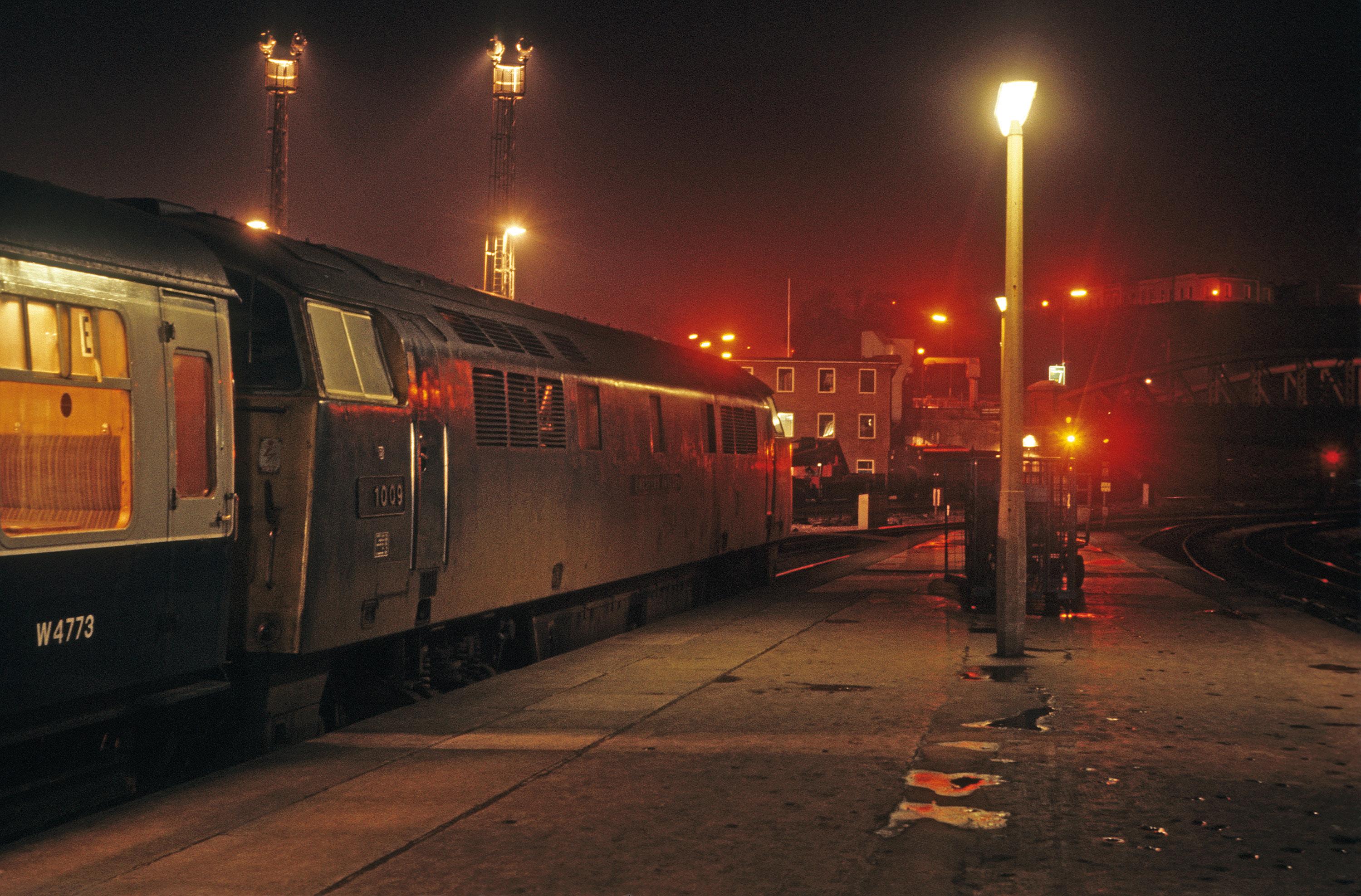 Above: The 4.45pm Paddington to Bristol Temple Meads service (1B95) has reached journey’s end behind (D)1009 Western Invader on Sunday 8 February 1976. The suggested warmth from within Mk.1 Tourist Second Open (TSO) No. W4773, undoubtedly contrasts with the evening temperature being experienced out on the platform.
Above: The 4.45pm Paddington to Bristol Temple Meads service (1B95) has reached journey’s end behind (D)1009 Western Invader on Sunday 8 February 1976. The suggested warmth from within Mk.1 Tourist Second Open (TSO) No. W4773, undoubtedly contrasts with the evening temperature being experienced out on the platform.
50
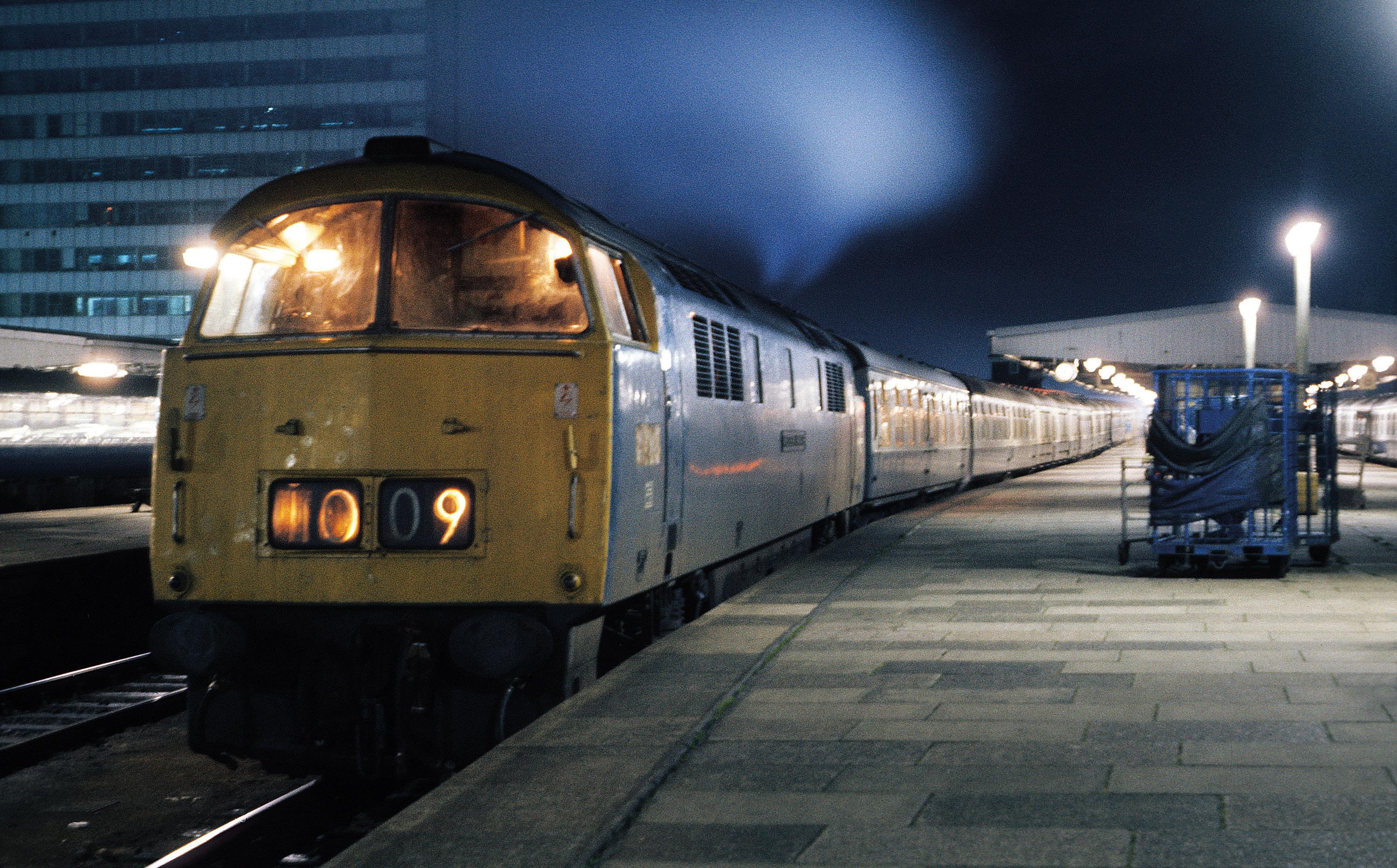
 Above: Exhaust erupts from the two Maybach MD655 power units of a numberplate-less D1009 Western Invader, as it departs a deserted Plymouth with the 1B94 6.0pm Penzance-Bristol Temple Meads on 16 October 1976. The long hot summer all but forgotten.
Above: Exhaust erupts from the two Maybach MD655 power units of a numberplate-less D1009 Western Invader, as it departs a deserted Plymouth with the 1B94 6.0pm Penzance-Bristol Temple Meads on 16 October 1976. The long hot summer all but forgotten.
51 ISSUE 9
Below: Tripod equipped photographers can be seen capturing D1010 Western Campaigner at Yeovil Junction on the evening of 27 November 1976, whilst working the 1Z52 British Rail (Day Excursion) from Plymouth to Birmingham and return via Salisbury.
FOOTPLATE RECOLLECTIONS OF A LUCKY MAN
BRIAN WHEELER
InIssue 7 of Western Times (Summer 2023) we recounted the recollections of Brian Wheeler and his time as an apprentice and then fitter at Reading, Brian’s enthusiasm also creating a number of opportunities for him outside the normal apprentice scheme. As referred to in the first article, at the successful end of his apprenticeship Brian applied for and was successfully appointed on to a supervisory course starting on 19 March 1962. This was for 63-weeks duration and although he was now notionally based at Paddington onsite experience was a considerable part of the course.
He was now issued with a footplate pass and recalls several footplate trips from that time. It is the story of those trips and the notes made at the time that now form the basis for this second instalment of recollections.
Brian’s records indicate he made a total of 43 footplate trips between 18 May and 26 October 1962 travelling from Paddington north to Birmingham, Wolverhampton and Shrewsbury, west to Bristol, Weston Super Mare and Cardiff, and south to Eastleigh, Southampton and Bournemouth. Most were by steam although Hymek, Warship, Western and even a lowly diesel unit were also represented. These then are the recollections of a man in a privileged position in the twighlight years of steam on the Western Region:
18 May 1962 - 2.45pm Wolverhampton Low Level to Paddington. No. 6021 King Richard II (81A); ten coaches, 358 tons. Driver Gardner (OOC). Departed on time but 7 late upon arrival at Banbury – reason not stated. Maximum of 92 mph at Gerards Cross with cut off at 18% and second valve of regulator. Engine riding and steaming well. Signals at Denham, 5 minute late arrival at Paddington.
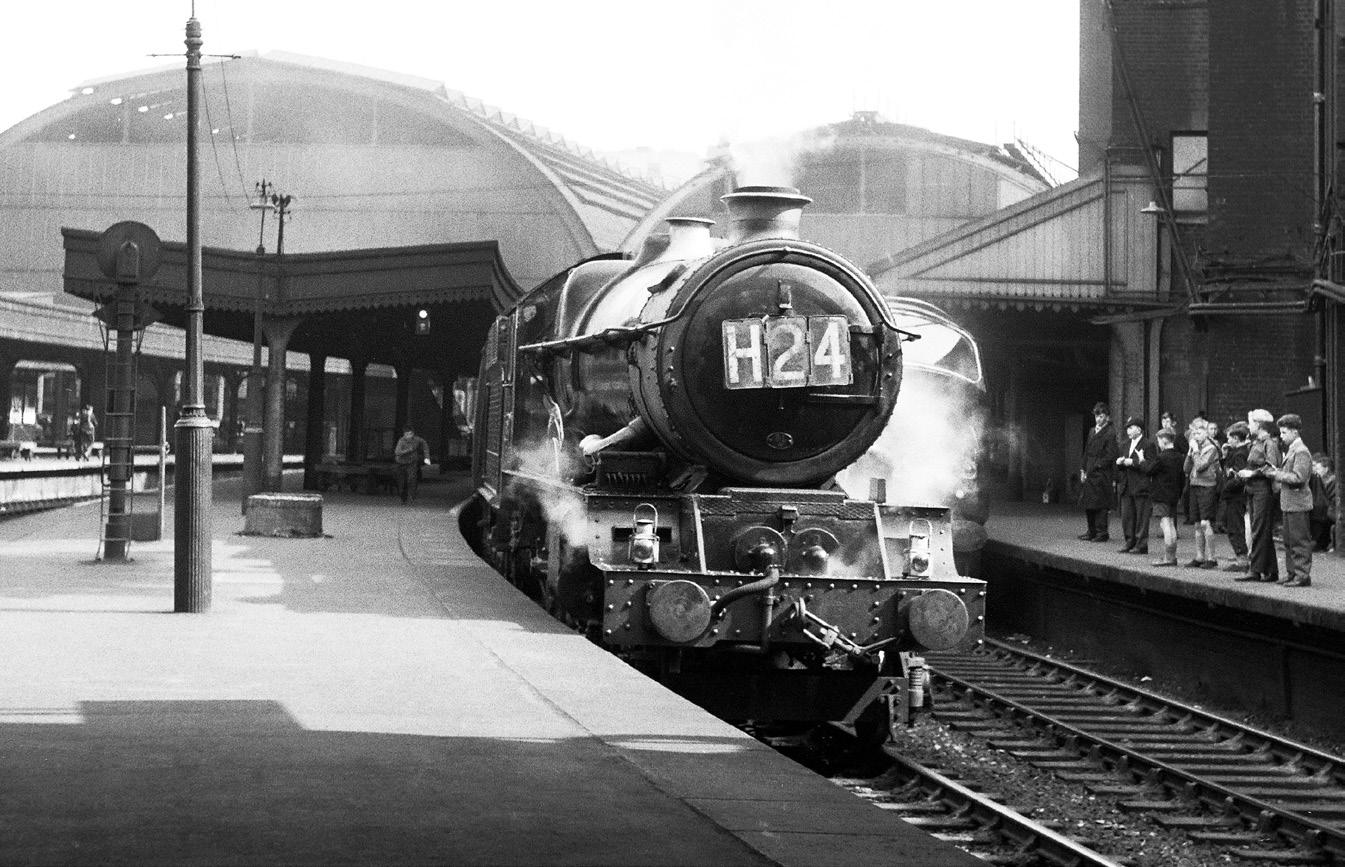
12 July 1962 - 12.10pm Paddington to Birkenhead (Woodside). No. 6028 King George VI. 12 coaches, 411 tons. Driver Dyer (Stafford Road). Footplate as far as Birmingham Snow Hill; only notes that engine rode well with boiler pressure maintained at 230-235 psi. 58mph noted at Princes Risborough.
13 July 1962 - 5.30pm Oxford to Paddington. No. 5065 Newport Castle (81A); six coaches, 180 tons. Driver Sneade (Oxford). Departed on time but p/way check at Didcot. Maximum of 88mph near Reading, eased to 75 mph at Twyford. Further signal check at Acton. Arrival at Paddington 3 minutes early at 6.27pm. Noted regulator was stiff, engine riding and steaming well, worked in 15% cut off on second valve.
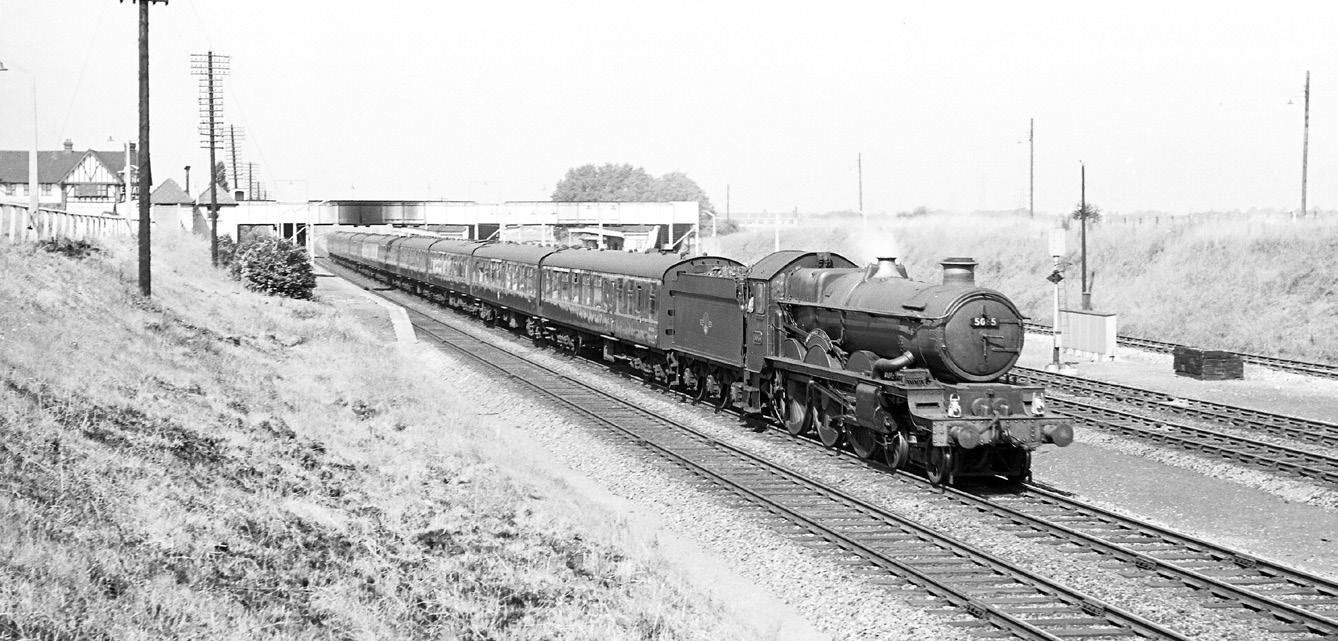
14 July 1962 - 9.45am Paddington - Weston Super Mare (as far as Bristol). No. 7006 Lydford Castle (81A), 13 coaches, 435 tons. Driver Ward (OOC). Despite checks at Reading and Didcot, 2 minutes early at Swindon where water was taken. One minute late departure from Swindon, maximum 80mph at Dauntsey where engine eased. Signal checks at Bathhampton and MP 115. Arrival at Temple Meads half minute late. Engine riding and steaming fair, worked at 18% cut off on first valve.
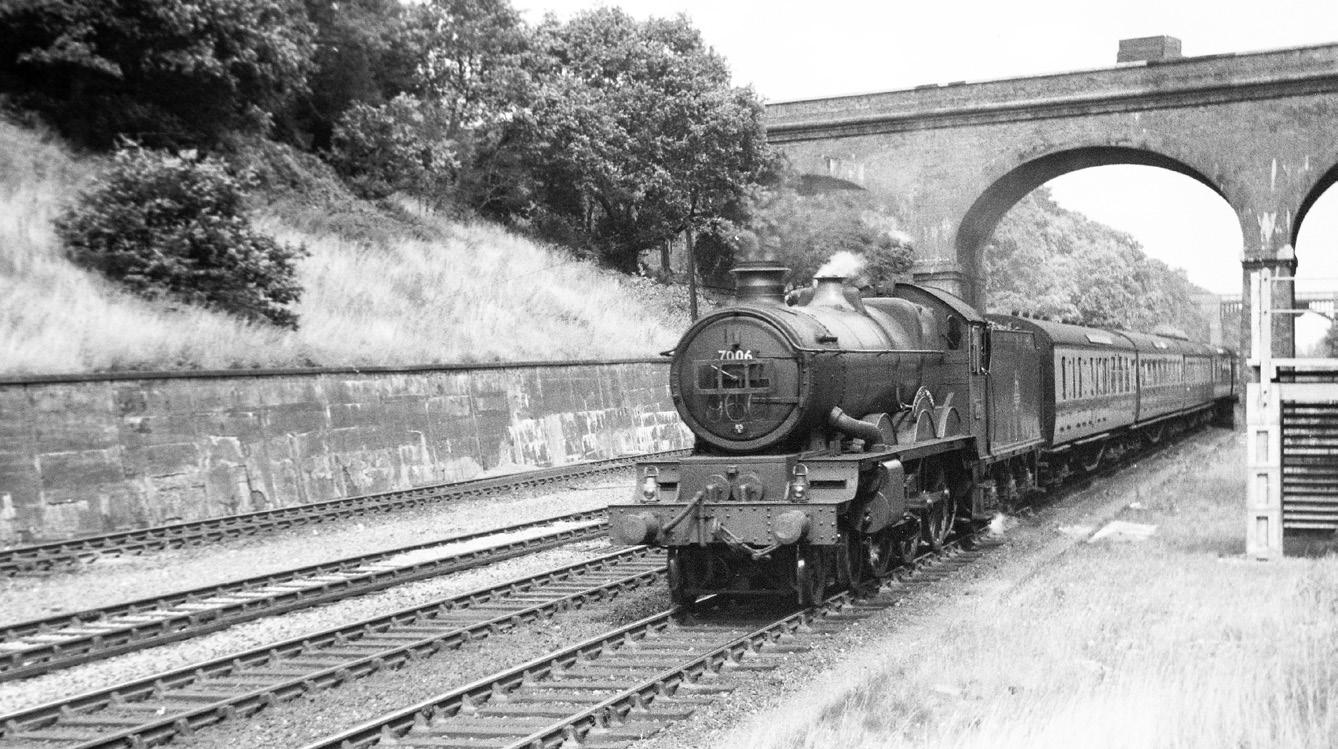 No. 7006 Lydford Castle on the down main in Sonning Cutting, 24 July 1950. R E Vincent.
No. 5065 Newport Castle (81A) is captured passing Iver with an Up working on 1 July 1962.
With an admiring audience opposite on Platform 1, ‘King’ Class 4-6-0 No. 6021 King Richard II (81A) awaits departure from Paddington on 15 April 1961. JLS.
No. 7006 Lydford Castle on the down main in Sonning Cutting, 24 July 1950. R E Vincent.
No. 5065 Newport Castle (81A) is captured passing Iver with an Up working on 1 July 1962.
With an admiring audience opposite on Platform 1, ‘King’ Class 4-6-0 No. 6021 King Richard II (81A) awaits departure from Paddington on 15 April 1961. JLS.
58
TIMES
WESTERN
18 July 1962 - Oxford to Eastleigh freight. Churchward 2-6-0 No. 6309 (81E), 39 wagons – no train weight given – 15 vacuum fitted. Driver Potter (Didcot). Departure from Oxford North yard at 3.40pm, one conflat added at Hinksey yard. Stopped for water at Newbury East Junction, passed up freight on single line at Burghclere. Arrived Eastleigh down yard 7.03pm. Engine to shed by SR men. After a break the return trip was with tank cars behind a 9F working a Fawley to Bromford Bridge via Newbury. Brian fired part of the way commenting, ‘I did not like the 9F and would have much preferred a 28’. Brian left the train at Didcot and where the Didcot men were also relieved.
19 July 1962 - 12.7pm Gloucester to Paddington. No. 7034 Ince Castle (85B), five coaches, 168 tons to Swindon. Driver Beard (Gloucester). Departed Gloucester on time, p/way check at Tuffley Junction, water taken at Kemble. One minute late arrival at Swindon. Six coaches added at Swindon (ex 11.40am from Weston Super Mare), train now 11 coaches, 379 tons. Departure from Swindon on time, 63mph at Didcot but engine eased owing to priming badly otherwise riding and steaming well. Maximum 65mph at Reading. Signal checks at Maidenhead and Acton. Worked at 18% cut off on first valve from Swindon. One minute late arrival at Paddington.

20 July 1962 - On this day Brian took what was perhaps a trip best described as ‘eventful’. This was on the train engine of the down ‘Pines Express’ from Bath Green Park to Bournemouth West. The load was 12 coaches, 430 tons, behind No 73051 (82F) in charge of Driver Brewer from Branksome. Assistance was provided by No. 73049 (82F) south from Bath to Evercreech Junction. Because of the length of the train Brian had to walk along the footboards to first reach the engine whereupon he called up to the driver that he had a footplate pass issued from Paddington. The response was best described as ‘frosty’, for as he was quick to discover from Bert Brewer, Brian represented the dreaded Western Region and who appeared intent on running down the S&D. Departure from Bath Green Park at 4.9pm was on time with both engines worked
at 60% cut off and full regulator from Bath through the Devonshire and Combe Down tunnels. Both engines being worked hard with cut offs varying from 70% to 25% for long periods. It was only by Midford that this came down to 55% and at Binegar where it was eased further to 50%. Cut off was increased later to 65-70% upon departing from Poole and remained in this position all the way to the top of Parkstone Bank. Brian recounts that the locomotive steamed well, although the quality of the coal was indifferent. The mechanical condition of the engine was fair whilst the external condition was poor ‘…for working a train of this class.’ A verbal recollection not included on his contemporaneous record was that the atmosphere on the footplate was also ‘hot’ to say the least. Bert Brewer not impressed that a man from ‘the dreaded Western Region’ was on board. In the end a mutual love and respect for the steam engine shone through and they parted the best of friends.
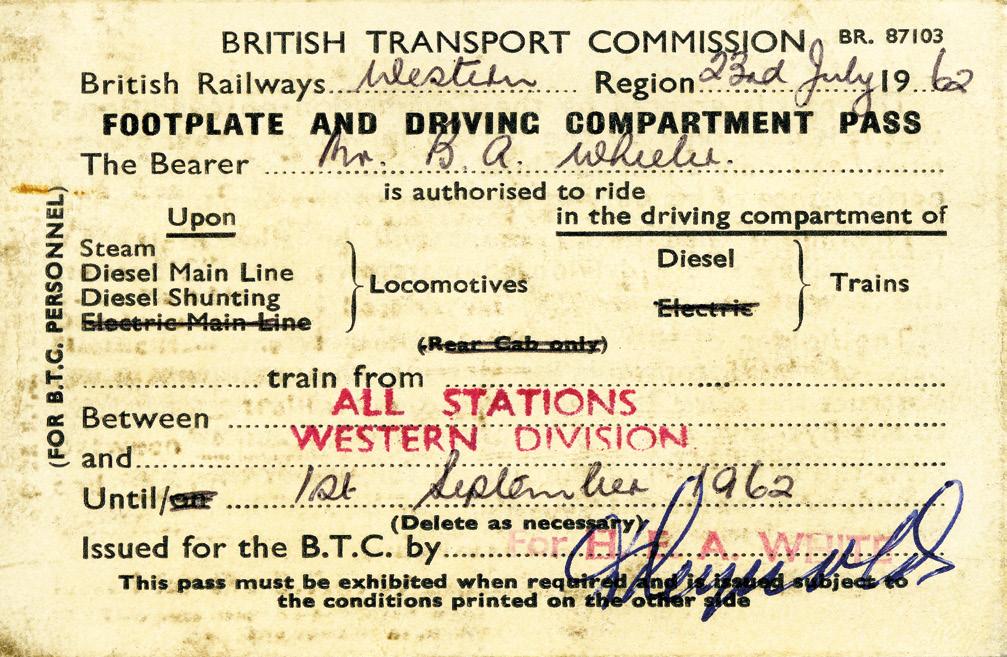
25 August 1962 - 8.45am Paddington to Weston Super Mare. No. 6018 King Henry VI (81A). 13 coaches, 432 tons. Driver Battams (OOC). Departure on time with a maximum of 70mph before Reading. Water taken on the troughs at Goring and again during the stop at Swindon. Three signal checks en-route and a 20mph restriction for relaying on Dauntsey bank. Two minute late arrival at destination (12.02pm). Engine steaming well but only riding fair. 18% cut off on first valve.
Upon arrival at Weston, Brian quickly swapped footplates on to No. 45725 Repulse, on what the first leg of the through train from Weston to Sheffield which he rode as far as Bristol. The load was 10 coaches, 327 tons with Driver Glasspool of Barrow Road in charge. Departure was on time at 12.15pm but signals brought the train to stand just four minutes later (this was due to the late running of the 12.08pm ex Ilfracombe service also from Weston bound for Manchester). A maximum of 64mph was achieved past Flax Bourton with the train 9 minutes late into Bristol. Brian’s comments on this LMR machine are not particularly complimentary. ‘Engine steamed well but riding rough…..not fit for passenger work due to excessive play in trailing boxes etc. Engine worked in 20% cut off with second valve when recovering from 25-30mph to 60mph.’
There was a third trip on the same day enabling Brian to return to Reading on what was the 1.15pm Bristol Temple Meads to Paddington. This was behind No. 5943 Elmdon Hall (82C). The load was 12 coaches, 374 tons. Driver Battans was again in charge. There was a one minute late departure from Bristol after which
A grimy No. 7034, devoid of its Ince Castle nameplates, stands alongside sister engine No. 7029 Clun Castle at Gloucester Horton Road shed on 19 February 1965.
59 ISSUE 9



£12.95








 Above: Dean 4-4-0ST No. 13, as rebuilt from 2-4-2BWT in 1897, standing in the Brixham bay at Churston circa 1906. The first vehicle is a Diagram S7 Tadpole, a 4-wheel fish truck with planked ends and doors, and barred sides. The coach rake appears to comprise elliptical roofed 4-wheel Brake Composites at either end with a Clerestory All Third in between. The scene provides period interest in the baulk road, the home signal set between the running lines, the gas lamps and station fencing.
Above: Dean 4-4-0ST No. 13, as rebuilt from 2-4-2BWT in 1897, standing in the Brixham bay at Churston circa 1906. The first vehicle is a Diagram S7 Tadpole, a 4-wheel fish truck with planked ends and doors, and barred sides. The coach rake appears to comprise elliptical roofed 4-wheel Brake Composites at either end with a Clerestory All Third in between. The scene provides period interest in the baulk road, the home signal set between the running lines, the gas lamps and station fencing.
 Above: The 4.45pm Paddington to Bristol Temple Meads service (1B95) has reached journey’s end behind (D)1009 Western Invader on Sunday 8 February 1976. The suggested warmth from within Mk.1 Tourist Second Open (TSO) No. W4773, undoubtedly contrasts with the evening temperature being experienced out on the platform.
Above: The 4.45pm Paddington to Bristol Temple Meads service (1B95) has reached journey’s end behind (D)1009 Western Invader on Sunday 8 February 1976. The suggested warmth from within Mk.1 Tourist Second Open (TSO) No. W4773, undoubtedly contrasts with the evening temperature being experienced out on the platform.

 Above: Exhaust erupts from the two Maybach MD655 power units of a numberplate-less D1009 Western Invader, as it departs a deserted Plymouth with the 1B94 6.0pm Penzance-Bristol Temple Meads on 16 October 1976. The long hot summer all but forgotten.
Above: Exhaust erupts from the two Maybach MD655 power units of a numberplate-less D1009 Western Invader, as it departs a deserted Plymouth with the 1B94 6.0pm Penzance-Bristol Temple Meads on 16 October 1976. The long hot summer all but forgotten.


 No. 7006 Lydford Castle on the down main in Sonning Cutting, 24 July 1950. R E Vincent.
No. 5065 Newport Castle (81A) is captured passing Iver with an Up working on 1 July 1962.
With an admiring audience opposite on Platform 1, ‘King’ Class 4-6-0 No. 6021 King Richard II (81A) awaits departure from Paddington on 15 April 1961. JLS.
No. 7006 Lydford Castle on the down main in Sonning Cutting, 24 July 1950. R E Vincent.
No. 5065 Newport Castle (81A) is captured passing Iver with an Up working on 1 July 1962.
With an admiring audience opposite on Platform 1, ‘King’ Class 4-6-0 No. 6021 King Richard II (81A) awaits departure from Paddington on 15 April 1961. JLS.



